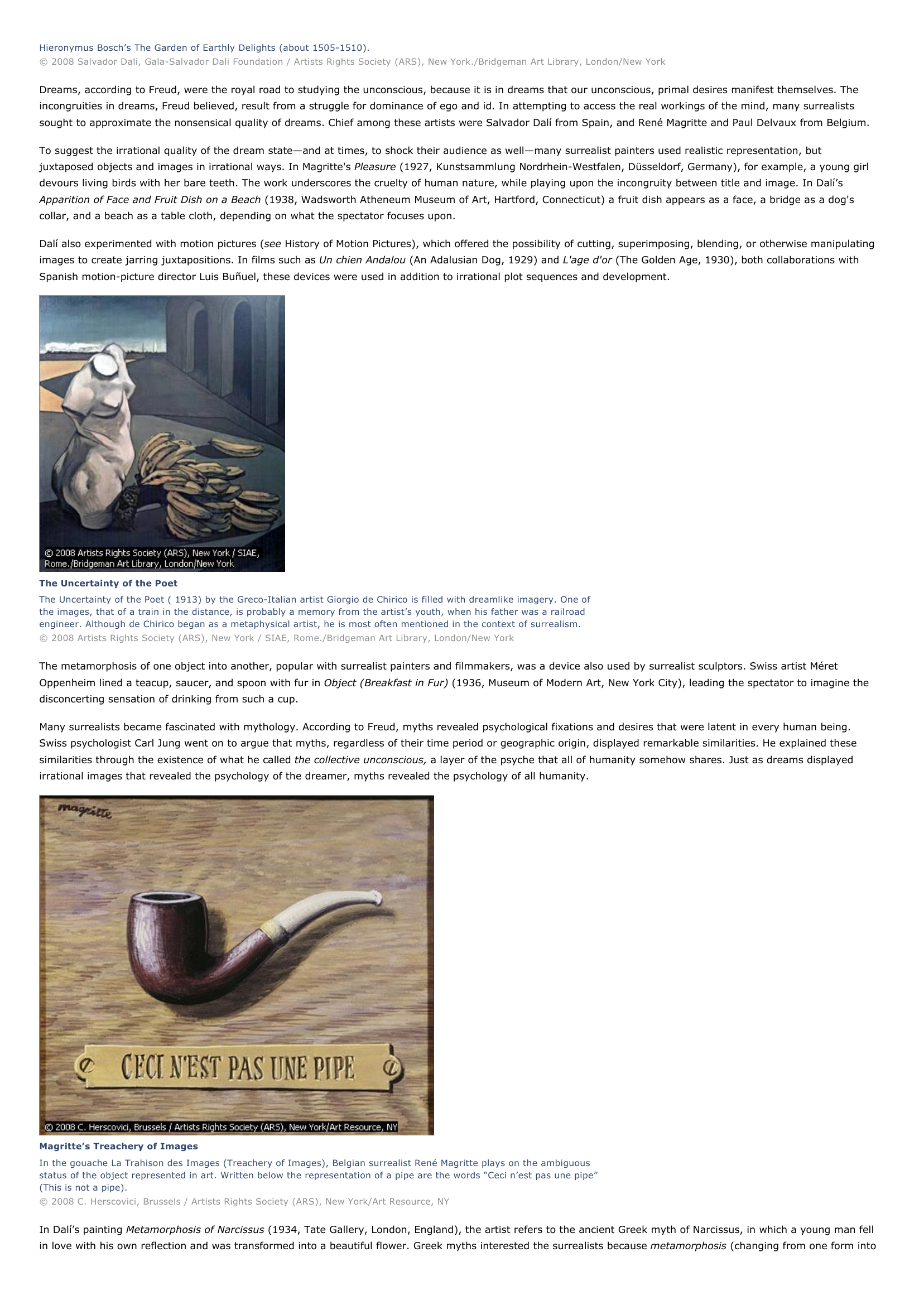Surrealism I INTRODUCTION Surrealism, artistic and literary movement that explored and celebrated the realm of dreams and the unconscious mind through the creation of visual art, poetry, and motion pictures.
Publié le 12/05/2013

Extrait du document
«
Hieronymus Bosch’s The Garden of Earthly Delights (about 1505-1510).© 2008 Salvador Dali, Gala-Salvador Dali Foundation / Artists Rights Society (ARS), New York./Bridgeman Art Library, London/New York
Dreams, according to Freud, were the royal road to studying the unconscious, because it is in dreams that our unconscious, primal desires manifest themselves.
Theincongruities in dreams, Freud believed, result from a struggle for dominance of ego and id.
In attempting to access the real workings of the mind, many surrealistssought to approximate the nonsensical quality of dreams.
Chief among these artists were Salvador Dalí from Spain, and René Magritte and Paul Delvaux from Belgium.
To suggest the irrational quality of the dream state—and at times, to shock their audience as well—many surrealist painters used realistic representation, butjuxtaposed objects and images in irrational ways.
In Magritte's Pleasure (1927, Kunstsammlung Nordrhein-Westfalen, Düsseldorf, Germany), for example, a young girl devours living birds with her bare teeth.
The work underscores the cruelty of human nature, while playing upon the incongruity between title and image.
In Dalí’sApparition of Face and Fruit Dish on a Beach (1938, Wadsworth Atheneum Museum of Art, Hartford, Connecticut) a fruit dish appears as a face, a bridge as a dog's collar, and a beach as a table cloth, depending on what the spectator focuses upon.
Dalí also experimented with motion pictures ( see History of Motion Pictures), which offered the possibility of cutting, superimposing, blending, or otherwise manipulating images to create jarring juxtapositions.
In films such as Un chien Andalou (An Adalusian Dog, 1929) and L'age d'or (The Golden Age, 1930), both collaborations with Spanish motion-picture director Luis Buñuel, these devices were used in addition to irrational plot sequences and development.
The Uncertainty of the PoetThe Uncertainty of the Poet ( 1913) by the Greco-Italian artist Giorgio de Chirico is filled with dreamlike imagery.
One ofthe images, that of a train in the distance, is probably a memory from the artist’s youth, when his father was a railroadengineer.
Although de Chirico began as a metaphysical artist, he is most often mentioned in the context of surrealism.© 2008 Artists Rights Society (ARS), New York / SIAE, Rome./Bridgeman Art Library, London/New York
The metamorphosis of one object into another, popular with surrealist painters and filmmakers, was a device also used by surrealist sculptors.
Swiss artist MéretOppenheim lined a teacup, saucer, and spoon with fur in Object (Breakfast in Fur) (1936, Museum of Modern Art, New York City), leading the spectator to imagine the disconcerting sensation of drinking from such a cup.
Many surrealists became fascinated with mythology.
According to Freud, myths revealed psychological fixations and desires that were latent in every human being.Swiss psychologist Carl Jung went on to argue that myths, regardless of their time period or geographic origin, displayed remarkable similarities.
He explained thesesimilarities through the existence of what he called the collective unconscious, a layer of the psyche that all of humanity somehow shares.
Just as dreams displayed irrational images that revealed the psychology of the dreamer, myths revealed the psychology of all humanity.
Magritte’s Treachery of ImagesIn the gouache La Trahison des Images (Treachery of Images), Belgian surrealist René Magritte plays on the ambiguousstatus of the object represented in art.
Written below the representation of a pipe are the words “Ceci n’est pas une pipe”(This is not a pipe).© 2008 C.
Herscovici, Brussels / Artists Rights Society (ARS), New York/Art Resource, NY
In Dalí’s painting Metamorphosis of Narcissus (1934, Tate Gallery, London, England), the artist refers to the ancient Greek myth of Narcissus, in which a young man fell in love with his own reflection and was transformed into a beautiful flower.
Greek myths interested the surrealists because metamorphosis (changing from one form into.
»
↓↓↓ APERÇU DU DOCUMENT ↓↓↓
Liens utiles
- William Faulkner I INTRODUCTION William Faulkner Twentieth-century American novelist William Faulkner wrote novels that explored the tensions between the old and the new in the American South.
- Iranian Art and Architecture I INTRODUCTION Iranian Art and Architecture, the visual arts of Iran.
- Mesopotamian Art and Architecture I INTRODUCTION Mesopotamian Art and Architecture, the arts and buildings of the ancient Middle Eastern civilizations that developed in the area (now Iraq) between the Tigris and Euphrates rivers from prehistory to the 6th century BC.
- Native American Art I INTRODUCTION Native American Art, the visual works crafted by indigenous people of North America, starting after their arrival on the continent thousands of years ago and continuing until the present.
- Pop Art Pop Art, visual arts movement of the 1950s and 1960s, principally in the United States and Britain.












